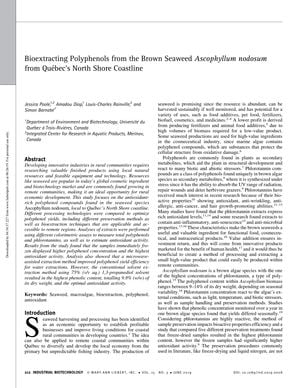Bioextracting Polyphenols from the Brown Seaweed Ascophyllum Nodosum from Québec's North Shore Coastline
June 2019
in “
Industrial Biotechnology
”

TLDR Freezing brown seaweed right after harvesting and using microwave-assisted extraction with 75% 1,3-propanediol as a solvent is the best way to get polyphenols for cosmetics.
The study focused on optimizing the extraction of polyphenols from Ascophyllum nodosum, a type of brown seaweed, to benefit rural communities and the cosmeceutical industry. It was found that freezing the seaweed immediately after harvest resulted in the highest polyphenol concentrations and antioxidant activity. The most effective extraction method was microwave-assisted extraction, which increased efficiency by 36% compared to conventional methods. The best solvent for extracting the highest phenolic content, at 9.8% of the seaweed's dry weight, was 75% 1,3-propanediol. The research also noted that the phenolic content varied with the location and season of harvest, with lower concentrations near freshwater sources. The study concluded that freezing is the optimal preservation method, 75% 1,3-propanediol is an effective solvent for the cosmeceutical industry, and microwave-assisted extraction is recommended for efficiency. Statistical significance was determined using ANOVA with a p-value < 0.05, and specific phenolic concentrations and IC50 values were provided to support the findings.
